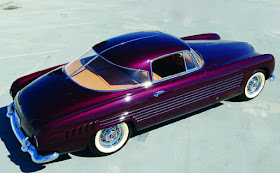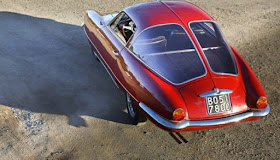After releasing 50 examples of its Turbine Car to selected drivers and offering rides at the 1964 New York World's Fair (photo below), Chrysler continued Turbine development through the 1970s, endeavoring to improve the engine's performance in key areas like throttle lag, high fuel consumption at idle, and compensating for lack of the engine braking effect which is familiar to drivers who lift off the accelerator on a piston engine.
They managed to do quite well, improving EPA-tested mpg to the mid-20s for the 7th generation turbines which arrived in 1977. While this figure in itself was not impressive when compared with the imports, especially Japanese ones, which were then taking greater market share in post-Fuel Crisis America, the figure becomes more interesting when one considers that the turbine could run on cheaper, non-fossil fuel, such as vegetable oil. Engineers even learned how to curb the engine's nitrous oxide emissions, which had been a weak point of the turbines compared to piston engines. By the use of improved regenerators, which extracted heat from the exhaust for re-use in compression and combustion, engineers reduced the exhaust temperature at the tail pipe to less than that of a piston engine car. Throughout this period, it seemed a worthwhile effort because of the inherent advantages of the gas turbines, which are their high power-to-weight and power-to-size ratios, and the reduction in the number of moving parts…the turbine having 80% fewer than a comparably-performing V8. And then there was the fact that the turbine had no radiator, no cooling system in the conventional sense, a single spark plug, and no need for oil changes…
Despite these advantages, Chrysler discontinued the automotive turbine program in the 1980s. Three factors spelled the end of the road for the gas turbine car. One was the tightening EPA emissions regulations. Gas turbines and jets are happiest running at a constant speed, and are less efficient in stop-and-go driving. So it was harder for turbines to deliver clean emissions in urban cycle testing. Another factor was the manufacturing cost of the engines; because of their high operating speeds and temperatures, the engines required exotic and expensive metals. If the 1964 Turbine Car had been offered for sale that year, the price would have been around $13,500…around twice the cost of a Chrysler Imperial. And the third, most compelling reason was economic as well. A condition of the Federal Chrysler Loan Guarantee Act which bailed out the company when Jimmy Carter signed it into law in early 1980 was the abandonment of the turbine program. Chrysler turbine engines did go into the Abrams tank, however. Those tanks would get attention from specially trained jet mechanics unavailable at the average Chrysler dealer, and that was one reason Chrysler decided to keep only 9 of the original 50 Turbine Cars from the 1963-66 test program, and scrapped the rest. Of those, 2 cars are in private collections and the rest are in Chrysler's museum or on loan to other museums. For a drive in Jay Leno's Chrysler Turbine, along with a look at turbine engine basics as well as rare footage of the cars being assembled, you should Google "1963 Chrysler Turbine: Ultimate Edition-Jay Leno's Garage-You Tube".
Photo credits: wikimedia







































